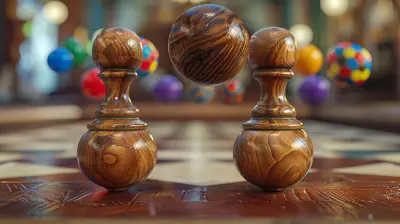The Role of Sound in Elevating Your Casual Game Experience
18 June 2025
Let's be honest: we’ve all been there, sprawled out on the couch, phone in one hand and snacks in the other, diving into yet another casual game to pass the time. Whether it's crushing candy with reckless abandon or flinging disgruntled birds at precariously balanced pigs, casual games have become our go-to boredom busters. But have you ever paused mid swipe or tap to appreciate why these games feel so satisfying? No, it’s not just the dopamine rush of beating your high score. The unsung hero here, folks, is sound.
That’s right, the chirps, dings, whooshes, and occasional triumphant fanfare aren’t accidental. They’re masterfully designed to mess with your brain in the best way possible. So, pull your thumbs off the screen for a sec and let’s dive into why sound is the secret sauce that takes your casual gaming experience from “meh” to "OMG, this game is my life now.” 
Why Sound is the MVP of Game Design
Imagine this: You’re playing your favorite puzzle game, and you’ve just lined up a colossal move. You swipe, the pieces cascade into place, and… silence. No satisfying ding, no glittering chime of success, just awkward quiet. Boring, right? That’s like eating pancakes without syrup—technically fine, but also deeply unsatisfying.The truth is, sound in casual games isn’t just a nice-to-have; it’s more like oxygen. Game designers use sound to guide you, reward you, and sometimes straight-up manipulate you into playing longer. (Yep, your game has been gaslighting you with cheerful noises. Congrats!) 
The Science of Sound: Why Your Brain Can't Resist
Let’s talk science for a hot second. Sound taps directly into the emotional centers of your brain. Every time you hear that euphoric "level up" chime, your brain releases a hit of dopamine—the very same chemical that makes puppies adorable and chocolate irresistible.It’s why you instinctively feel good when you nail a move in your favorite word game and hear that sparkling sound effect. It's not just a noise; it's validation in audio form. Basically, game sound effects are the over-the-top cheerleader you never knew you needed, screaming "YOU'RE AMAZING!" every time you solve a 2x2 puzzle. 
Sound as a Reward: The Audio Equivalent of a Gold Star
Think about the satisfaction of opening a treasure chest in a game. The lid creaks open, you hear a magical whoosh, and then—BOOM—sparkly noises explode along with a jingle that screams, “YOU’RE RICH!” Did it matter that the treasure is just virtual coins that don’t exist outside your screen? Not one bit.Casual games know this and use it to their advantage. The sound effects are carefully crafted to make you feel like a tiny, triumphant god in your 5-minute breaks. It’s Pavlovian conditioning at its finest. You tap, you hear a reward sound, and suddenly, you’re smiling like an idiot. 
Background Music: Setting the Mood (Or Driving You Bonkers)
Now, let’s not forget the unsung hero of game sounds: the background music. Here’s where things get spicy. Done right, background music can draw you into the game’s vibe, whether it’s a chill lo-fi vibe for a zen puzzler or a fast-paced beat for an action-packed endless runner.But, let’s be real, some games totally abuse this privilege. Ever quit a game just because its music was on an endless, repetitive loop that made you want to throw your phone out the window? Same. The trick is subtlety—music should enhance the experience, not make you question your life choices.
How Sound Effects Make You Feel Smart
Here’s a cheeky little secret: sound effects in casual games are designed to make you feel way smarter than you actually are. That satisfying click when you connect two tiles? It’s engineered to make you believe you’ve just solved a quantum physics equation when, in reality, you've identified two matching pictures.The audio cues are there to create a feedback loop. You do something “intelligent,” the game rewards you with a pleasing sound, and now you’re convinced you’re basically Einstein. It’s a beautiful, self-delusional cycle, and honestly, I’m here for it.
The Dark Side of Silence
Picture this: you’re on a killer streak, obliterating level after level, and suddenly, the game glitches. No sound. Just your own awkward finger taps echoing into the void. Doesn’t that feel…wrong?Silence in a casual game is like watching a sitcom without the laugh track. Sure, the content’s the same, but it feels hollow and awkward. The absence of sound doesn’t just make the game boring—it actively breaks the immersion. This is why even the simplest mobile games pour tons of effort into their sound design.
Sound and Immersion: Why You Keep Coming Back
You know that weirdly hypnotic feeling where you tell yourself, “Just one more level,” and two hours later, you're still at it? Yeah, you can blame sound for that. Immersive audio is one of the reasons casual games are so addictive.The sound cues work in tandem with the visuals, sucking you into a state of flow where nothing else matters. Your boss? Forgotten. That email you were supposed to send? Whoops. The game’s audio becomes a cozy little cocoon, and suddenly, reality feels like a distant memory.
Accessibility: Sound Makes Games Inclusive
Now, let’s get serious for a second. For players with visual impairments, sound isn’t just an enhancement—it’s essential. Games with well-designed audio cues allow everyone to join the fun. Whether it’s a voiceover guiding you through levels or distinct sound effects signaling an action, sound can make casual games truly inclusive.So, the next time you’re rolling your eyes at a game’s over-the-top sound effects, just remember: for someone else, those sounds might be the only way they can play.
Is Sound Annoying? Maybe, But You’d Miss It
Alright, confession time. There are moments when game audio can be, uh, a bit much. We’ve all scrambled to mute our phone during an overly dramatic sound effect in public. (Pro tip: Nobody in line at the coffee shop wants to hear a 10-second "victory fanfare.")But here’s the thing: you’d miss it if it were gone. Sure, you might roll your eyes at a cheesy level-complete jingle or the cartoonish “boing” every time your character jumps, but without them, the game would feel…empty. It's like complaining about sprinkles on a cupcake—they’re unnecessary, but also kind of perfect.
The Future of Sound in Casual Games
As gaming continues to evolve, sound design is only getting better. Developers are experimenting with 3D audio, dynamic music that adapts to your gameplay, and even immersive soundscapes that make you feel like you’re actually in the game.Can you imagine playing a mobile game where the sound shifts based on how you tilt your device, or where the background music changes depending on your mood? Okay, maybe that’s a bit Black Mirror, but still—how cool would that be?
Final Thoughts: Don’t Take Sound for Granted
Next time you’re mindlessly matching tiles or popping balloons, take a moment to appreciate the sounds behind the chaos. The joyful dings, the quirky pops, the epic jingles—they’re all working in harmony to keep you hooked.So, yeah, sound in casual games? Totally underrated. It’s the secret sauce, the glue, the Beyoncé of game design. And now that you know its role in elevating your gaming experience, you’ll never look at that cheerful “game over” tune the same way again.
all images in this post were generated using AI tools
Category:
Casual GamesAuthor:

Whitman Adams
Discussion
rate this article
2 comments
Rachael McGivern
Great article! Sound truly has a remarkable way of immersing us in casual games. It enhances the atmosphere and can evoke emotions we didn’t realize we needed. I often find that a well-placed sound effect can transform an ordinary moment into something memorable. Thank you for sharing!
June 23, 2025 at 2:56 AM

Whitman Adams
Thank you for your insightful comment! I'm glad you enjoyed the article and appreciate how sound can truly transform the gaming experience.
Izaak Graham
Sound is the heartbeat of gaming, transforming ordinary moments into unforgettable experiences. Embrace the melodies and soundscapes that enhance your gameplay, as they create a deeper connection to the virtual world. Elevate your casual gaming journey—listen, feel, and enjoy!
June 22, 2025 at 2:34 AM

Whitman Adams
Absolutely! Sound truly enriches gameplay, turning everyday moments into immersive experiences. Embracing these auditory elements can elevate your gaming journey significantly. Enjoy the magic of sound!


